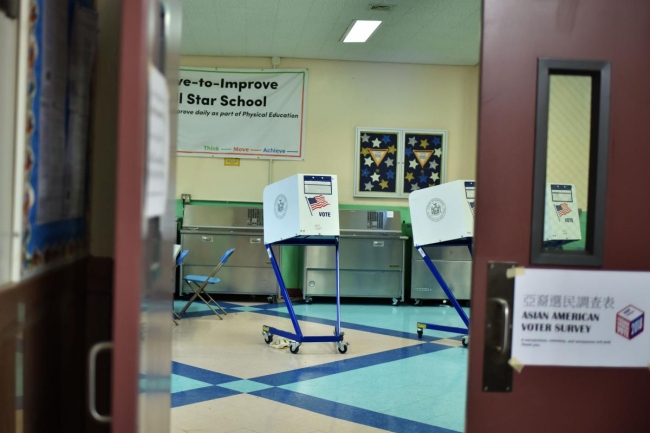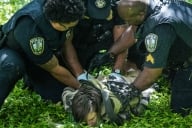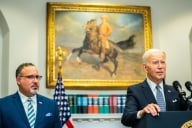You have /5 articles left.
Sign up for a free account or log in.

Getty Images
Turnout among college student voters more than doubled from the 2014 to 2018 midterm elections, according to a new report suggesting that a traditionally apathetic voting bloc may significantly influence next year’s presidential contest and politics at large.
Political researchers say efforts by colleges and universities to boost student civic engagement are paying off and that nearly 40 percent of students who were eligible to vote cast ballots in the 2018 elections, a significant upswing from 19 percent in the 2014 election. The change reflects a nationwide rise in voting participation in nearly every age demographic, but the spike among students is particularly noticeable.
The report released Thursday by Tufts University's Institute for Democracy and Higher Education details the surge in college student voting. The National Study of Learning, Voting and Engagement, which launched in 2013, is now widely considered to be the best gauge of student voting patterns.
The institute's researchers collected the enrollment records of 10 million students from more than 1,000 colleges and universities to determine registration and voter participation rates among their students. Institutions that take part in the study receive a tailored report with this information, which is often used to develop their civic learning and voter-engagement strategies. If many students at a particular campus take advantage of the early voting times, for example, administrators there might add another polling station during that period.
Administrative efforts on civic engagement were not so precise or common in the past, but college leaders are more keen to embrace the heightened student activism that emerged on campuses in the years preceding and following the 2016 election of Donald Trump, said Nancy Thomas, the director of the Tufts institute. The political climate and President Trump’s controversial rhetoric about issues such as immigration, gun violence, policing, free speech and racial topics spurred increased advocacy among students and drove them to the polls, Thomas said.
Although she stressed that the research could not attribute the increased political engagement solely to student reaction to the president or the policies of his administration, "I do think students were very motivated by the public policy issues right now, and issues of diversity and inclusion," she said.
At Harvard University, where the voting rate more than doubled from 2014 to 2018, about 49 percent of eligible voters cast ballots in the last midterm elections.
Teddy Landis, a senior at Harvard, said students “showed their voices mattered” over those four years.
“President Trump is on the TV all day, on our Twitter feeds all day; we are seeing him everywhere we go, and it made it less and less possible to sit on the sidelines,” Landis said.
The study also found that voting rates were up among students of all races.
About 24 percent of black women voted in the 2014 election, which was the highest of any demographic group, and the trend continued in 2018 with 43 percent of black women casting votes. The biggest increase in student voter participation was among Hispanic women -- 14 percent of them voted in 2014, but nearly 38 percent voted in 2018. Shifting student demographics at colleges may have contributed to changes in which racial groups voted more, the study notes.
Student voting rates, especially during a non-presidential-election year, have historically been poor, as the 2014 Tufts study showed. Thomas attributed past voting trends to college administrators’ reluctance to prioritize or promote political or civic engagement activities. Few college presidents want a repeat of the student activism movements of the 1960s and 1970s that roiled college campuses, or to have their offices occupied by angry students, Thomas said.
College administrators have also been nervous about increased scrutiny from some conservative lawmakers and their declining support for higher education. Multiple studies have demonstrated that Republicans in particular sometimes do not see the value in higher education. Fear of appearing overly political or partisan by promoting voting or voter registration drives on campus may have hamstrung administrators, Thomas said, adding that legislators’ negative opinions of higher education could lead them to slash universities’ budgets.
But now many more administrators are incorporating yearlong civic education across academic disciplines, holding more politically oriented programs on campus and adding opportunities for students to register to vote. Civic advocacy organizations nationwide work with college administrators to accomplish these goals.
Rachel Clay is the southeast regional coordinator of one such group, the Campus Vote Project, the student-focused arm of the nonpartisan Fair Elections Center, which tries to remove voting barriers. She works primarily with institutions in North Carolina.
Colleges should weave voter registration and lessons about voting into orientation and other programs and not treat it as a siloed issue, Clay said.
She said the most successful programs are those that give students every opportunity to register to vote. For instance, students at the University of North Carolina at Greensboro are given a checklist when they move out of the dormitories that asks them whether they've updated their voter registration with their new address.
College students already face unique barriers when attempting to vote. Though a 1979 Supreme Court decision, Symm v. United States, affirmed students' right to vote in the jurisdiction where they attend college, those jurisdictions sometimes attempt to prevent them voting on grounds of “not being a part of the community,” Clay said.
Students also may be unfamiliar with how to register in the state where they are enrolled, or the state might have laws that require certain identification that can be difficult to obtain.
Tennessee, for example, accepts all government-issued IDs -- but not a student ID. Texas also does not accept student IDs for voting and doesn’t offer same-day voter registration, so students must register by a certain deadline only a month or so into the academic year.
Lawmakers are taking notice that students -- who overwhelmingly tend to vote liberal -- may play a role in the upcoming election. Some lawmakers have tried to limit early voting centers on campuses, as a result. For example, the former Maine governor Paul LePage, a Republican, went so far as to disseminate misleading information about the requirements for voting.
Kim Reynolds, the Republican governor of Iowa, recently was accused of disenfranchising college voters by scheduling two special elections on dates when certain students would not be on campus.
Politico documented how Jerry Falwell Jr., president of Liberty University, a staunch conservative and Trump supporter, tried to shift the academic calendar so his student body, which is largely right-leaning, would be around to influence local elections.
“We’ve got this all over the country now, with people putting up barriers and impediments to the college student being able to register and being able to vote,” said Dan A. Lewis, director of the Center for Civic Engagement at Northwestern University.








